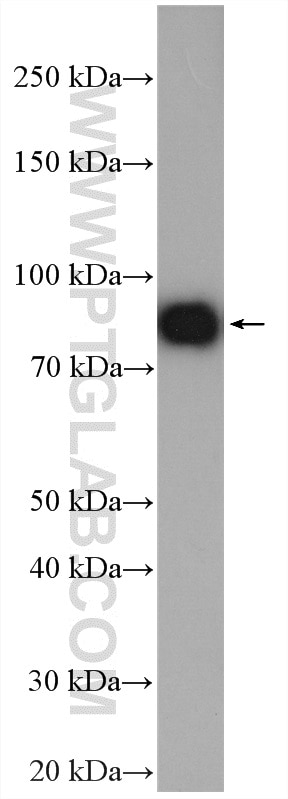Validation Data Gallery
Tested Applications
| Positive WB detected in | mouse brain tissue |
| Positive IP detected in | mouse brain tissue |
Recommended dilution
| Application | Dilution |
|---|---|
| Western Blot (WB) | WB : 1:500-1:2000 |
| Immunoprecipitation (IP) | IP : 0.5-4.0 ug for 1.0-3.0 mg of total protein lysate |
| It is recommended that this reagent should be titrated in each testing system to obtain optimal results. | |
| Sample-dependent, Check data in validation data gallery. | |
Published Applications
| IF | See 1 publications below |
Product Information
20953-1-AP targets KCNJ1 in WB, IP, IF, ELISA applications and shows reactivity with human, mouse, rat samples.
| Tested Reactivity | human, mouse, rat |
| Cited Reactivity | mouse |
| Host / Isotype | Rabbit / IgG |
| Class | Polyclonal |
| Type | Antibody |
| Immunogen | KCNJ1 fusion protein Ag15100 相同性解析による交差性が予測される生物種 |
| Full Name | potassium inwardly-rectifying channel, subfamily J, member 1 |
| Calculated molecular weight | 391 aa, 45 kDa |
| Observed molecular weight | 75-80 kDa |
| GenBank accession number | BC074752 |
| Gene Symbol | KCNJ1 |
| Gene ID (NCBI) | 3758 |
| RRID | AB_10732600 |
| Conjugate | Unconjugated |
| Form | Liquid |
| Purification Method | Antigen affinity purification |
| UNIPROT ID | P48048 |
| Storage Buffer | PBS with 0.02% sodium azide and 50% glycerol , pH 7.3 |
| Storage Conditions | Store at -20°C. Stable for one year after shipment. Aliquoting is unnecessary for -20oC storage. |
Background Information
KCNJ1, also called ROMK, is an inward-rectifying K+ channel responsible for basal (non-flow stimulated) K+ secretion. Inward rectifier potassium channels are characterized by a greater tendency to allow potassium to flow into the cell rather than out of it. Their voltage dependence is regulated by the concentration of extracellular potassium. This channel is activated by internal ATP and can be blocked by external barium. The calculated molecule weight is 45kDa, 20953-1-AP can detect the band around 75-80 kDa, it has been considered to be a dimer of KCNJ1.(PMID: 17804670; 7929082; 15767585)
Protocols
| Product Specific Protocols | |
|---|---|
| WB protocol for KCNJ1 antibody 20953-1-AP | Download protocol |
| IP protocol for KCNJ1 antibody 20953-1-AP | Download protocol |
| Standard Protocols | |
|---|---|
| Click here to view our Standard Protocols |
Publications
| Species | Application | Title |
|---|---|---|
Am J Physiol Renal Physiol (Pro)Renin Receptor Regulates Potassium Homeostasis through a Local Mechanism. |


